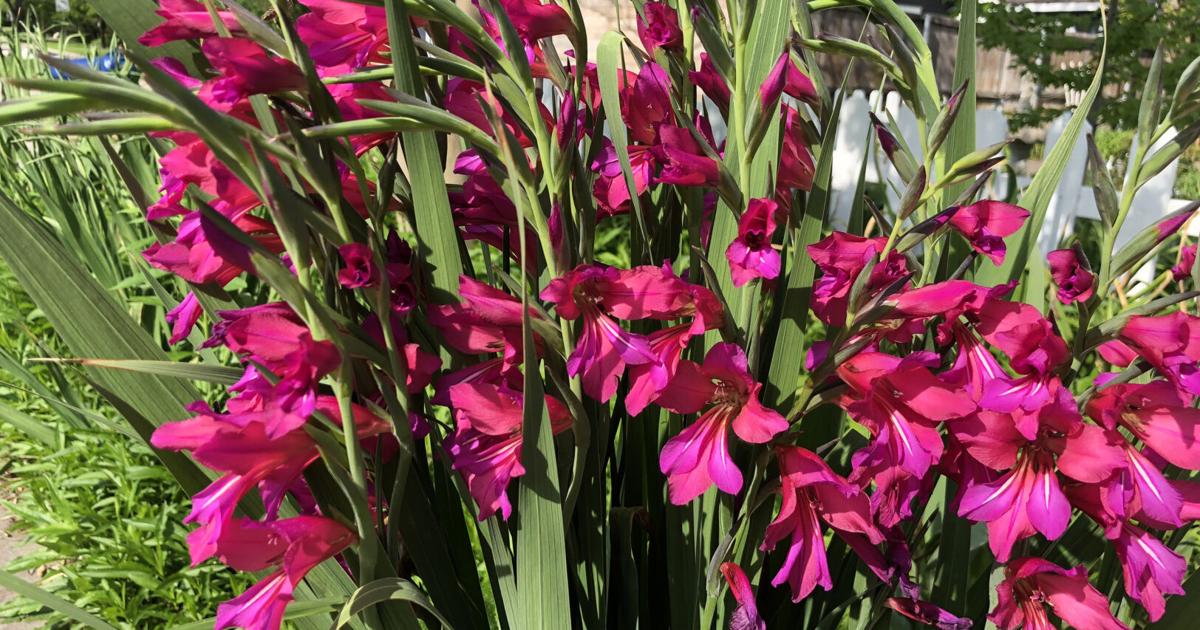
Dear Neil: I bought and planted Byzantine glads last fall. They came up and bloomed well this spring, but then their tops died almost immediately. I assume that’s normal, but I’m reworking that part of my perennial garden and if they aren’t going to come back, I’d like to plant something else.
A: They will come back. That assumes nothing bad happened to them over the summer. Byzantine glads are a treasured heirloom perennial you’ll see in older neighborhoods and in landscapes of savvy gardeners like you.
We have lived in a rural area for almost 50 years. Neighbors across the county road had a clump of them in their rundown landscape when we arrived. They never did anything to nurture them, and they survived for 30 years.
They moved away and left everything to tumble down 20 years ago, and the Byzantine glads still persist and bloom every spring. For anyone who doesn’t know them, this plant has lovely magenta flowers on spikes that are half the size of florist gladiolas, except these glads don’t have to be dug and stored every winter. If only we could have more plants like them.
Dear Neil: Will wild honeysuckle climbing into trees kill them? A: It could. First, it will form dense canopies over the tops of the trees and cast heavy shade onto their foliage. It’s semi-evergreen, so its leaves could also become coated in ice during a winter storm.
That could add weight to weak branches thereby causing them to break. Most importantly, however, its twining stems often encircle and girdle the trunks and branches of the trees. It constricts much like a python or boa constrictor.
Sugars manufactured in the leaves and then subsequently sent down the trunks to the roots becomes trapped above the constriction. It causes an overgrowth where it binds the trunk, and the conducting tissues fail to function. It’s imperative that we clip the honeysuckle’s stems before that can happen.
Dear Neil: When should I prune my Nellie R. Stevens holly? How much can I trim it? A: The best time to trim and reshape any evergreen shrub is late winter, a few weeks before the burst of spring growth. That’s especially important if you’re planning on doing any major pruning and reshaping, for example, converting a shrub-form plant into one that has more of a tree-like habit of growth.
Sometimes people don’t realize how large Nellie R. Stevens hollies can grow (to 15 to 20 feet tall and 12 or 14 feet wide). They plant them where a Willowleaf holly or even a dwarf Burford holly might have been a better choice.
If you’re trying to reduce the size of a Nellie R. Stevens, do so in late winter using lopping shears and a small pruning saw to remove branches one at a time so that you can conceal each cut stem with foliage you leave in place. However, if you find that the regrowth in the spring takes the plant back beyond the space you have available for it, you may need to consider moving it to a place with more room and replacing it with a smaller variety.
Dear Neil: I have four Hatch pepper plants and three Serrano pepper plants in pots of different sizes. Leaves on some plants have brown spots, while others’ leaves are wilting and falling off. I feed them once a week, and I water them every other day around their roots only.
I’d appreciate any advice you can give me. A: There are several unanswered questions. Are these in full sun on a patio? How old are the plants? (set out in the spring, or potted up this July?) Please describe the potting soil.
Are you sure the potting soil was dry before you watered the plants? Watering on a regular schedule like you describe could be too much or too little depending on temperature, sun, wind, soil and size of plant. A photo really would have helped, but those are all things you need to mull over as you and I try to determine the cause of your problems. Pots for peppers need to be at least 12 inches in diameter, probably larger for most standard-sized plants.
It’s best to start with fresh transplants in spring and a new set of transplants in mid-summer for the fall garden. When you grow peppers in pots, they can become rootbound very quickly. That will cause the plants to run into moisture issues.
Plant in fresh potting soil each year. Don’t try to save it from crop to crop. Organic matter in the potting soil breaks down rather quickly and the soil quality will deteriorate.
Brown spots at the tips of the leaves and around leaf edges suggest plants that have gotten too dry one or more times. If the soil is still wet when you’re watering, that’s overwatering, and those plants have lost many roots due to lack of oxygen in the soil. Peppers require full sunlight.
You can keep them alive in less light than that, but the plants will certainly struggle..














